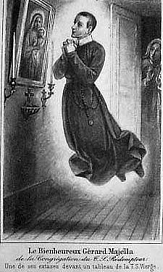 Saint Gerard Majella
Saint Gerard Majella
Redemptorist Coadjutor Brother (1726-1755)
Feast – October 16
Saint Gerard Majella is known as a Thaumaturge, a Saint who works miracles not just occasionally, but consistently throughout his life. It has been said that God raises up not more than one every century.
St. Gerard, the youngest of the five children of Dominic and Benedetta Galella Majella, was born on April 6, 1726, in the small town of Muro, about fifty miles south of Naples, Italy. He was very sickly at birth and was immediately taken to the Cathedral church for Baptism.
When he was only five, he was accustomed to go to a small chapel near his home to pray. Often, he would return home from these visits with a loaf of bread. When asked about this, he would say that “a most beautiful boy” had given it to him. One day his sister, Elizabeth, followed him to the chapel and watched him while he knelt in prayer before a statue of the Blessed Mother holding the Child Jesus. Then she saw a strange thing happen. The Child Jesus left His Mother’s arms and came down to play with the little boy. After some time, the Child gave Gerard a loaf of bread and returned to His Mother’s arms. St. Gerard wanted very much to receive Holy Communion at the age of seven and went to the Communion railing one day with the others; but the priest, seeing his age, passed him up; and he went back to his place in tears. The following night, Saint Michael the Archangel brought him the Communion he so much desired. His only ambition was to be like Jesus Christ in his sufferings and humiliations.
When St. Gerard was twelve, the sudden death of his father made it necessary for him to leave school and to begin to work. His mother sent him to her brother so that he could teach Gerard to sew and follow in his father’s footsteps. However, the foreman was abusive. St. Gerard accepted the persecution as being permitted by God for his spiritual good. Once he was seen to smile even while enduring a beating, and when asked about this, he said: “I was smiling because I saw the hand of God striking me.” His uncle soon found out and the man who taught him resigned from the job.
After four years of apprenticeship, he took a job as a servant to work for the local Bishop of Lacedonia, who was recuperating in Muro. Again, he manifested the virtue of patience by silently bearing the irascible temper of this otherwise worthy man. During this time one of his early miracles took place. One day he accidentally dropped the key of the house in the well. With saintly simplicity he lowered a small statue of the Infant Jesus into the well. To the amazement of the onlookers, when St. Gerard raised the statue the lost key was held in its hand. Upon the bishop’s death, he returned to his trade, working first as a journeyman and then on his own account. He divided his earnings between his mother and the poor and in offerings for the souls in Purgatory. As he grew older, when anyone spoke to him about marriage, he would answer: “The Madonna has ravished my heart, and I have made Her a present of it.” He desired to enter religion, but his health was unstable as a result of the mortifications he had constantly practiced as a young man.
He tried to join the Capuchin Order, attempting to become a hermit. Was refused because of his frail health. He was still determined to become a lay brother, and the occasion of a mission conducted by the Redemptorist Fathers in Muro gave him new hope. He asked to be admitted as a candidate in their order, but again was refused because they felt that his health would not endure the rigors of monastic life. So persistent was the young man, however, that Father Paul Cafaro, the superior of the missionaries, advised his mother to lock him in his room on the night they were leaving Muro, lest he try to follow them. St. Gerard’s mother did so, but the next morning when she unlocked the door, she found an empty bed, an open window from which hung a sheet, and a note on the table that read: “I have gone to become a Saint.”
In 1749, he joined the Congregation of the Most Holy Redeemer, known as Redemptorists. The order was founded in 1732 by Saint Alphonsus Liguori (1696-1787) at Scala, near Naples. This was essentially a missionary order dedicated to “preaching the word of God to the poor.” The apostolate focuses on the giving of missions and retreats. Two years later, he made his profession.
In his work with the Redemptorist community, he was variously a gardener, sacristan, tailor, porter, cook, carpenter, and clerk of works on the new buildings at Caposele.
Although weak in body, he did the work of four, still finding time to take on himself that of others. He would say: “Let me do it, I am younger, take a rest”. He made the heroic vow of always choosing what appeared to him most perfect. As a model of every virtue, he was so drawn to Our Lord in the tabernacle that he had to do violence to himself to keep away. His great charity earned for him the title of Father of the Poor.
St. Gerard was perfectly obedient to his superior’s wishes, even when not expressed; and one day, to demonstrate this to a visiting authority who required a proof, his immediate Superior sent him out, saying: “I will tell him interiorly to return; he needs no other command than this”. Soon the Brother knocked on the door once more and said: “You sent for me to come back?” Saint Alphonsus considered him a miracle of obedience.
True sanctity must always be tested by the cross, and it was in 1754 that Gerard had to undergo a great trial, one that may well have merited for him the special power to assist mothers and their children. One of his works of zeal was that of encouraging and assisting girls who wanted to enter the convent. Often, he would even secure the necessary dowry for some poor girl who could not otherwise be admitted into a religious order.
Neria Caggiano was one of the girls thus assisted by Gerard. However, she found convent life distasteful and within three weeks had returned home. To explain her action, Neria began to circulate falsehoods about the lives of the nuns, and when the good people of Muro refused to believe such stories about a convent recommended by St. Gerard, she determined to save her reputation by destroying the good name of her benefactor. Accordingly, in a letter to St. Alphonsus, the superior of Gerard, she accused the latter of sins of impurity with the young daughter of a family at whose house Gerard often stayed on his missionary journeys.
St. Gerard was called by St. Alphonsus to answer the accusation. Instead of defending himself, however, he remained silent, following the example of his Divine Master. In the face of his silence, St. Alphonsus could do nothing but impose a severe penance on the young religious. St. Gerard was denied the privilege of receiving Holy Communion and forbidden all contact with outsiders.
It was not easy for St. Gerard to give up his labours in behalf of souls, but this was a small penance compared with being deprived of Holy Communion. He felt this so keenly that he even asked to be freed from the privilege of serving Mass for fear that the vehemence of his desire to receive would make him seize the consecrated Host from the very hands of the priest at the altar.
Sometime later Neria fell dangerously ill and wrote a letter to St. Alphonsus confessing that her charges against St. Gerard had been sheer fabrication and calumny. An angel in purity bore the calumny with such patience that Saint Alphonsus said: “Brother Gerard is a saint.”
Much of his life as a brother was spent in traveling with and assisting the missionaries. They deemed him an invaluable companion, because he had such remarkable success in bringing sinners to the Sacraments and in inducing many to repair their past bad Confessions. People followed him everywhere.
He was favored with infused knowledge of the highest order, prophecy, discernment of spirits, and penetration of hearts and with what seemed an unlimited power over nature, sickness, and the devils.
He frequently fell into ecstasy while meditating on God or His holy will and at such times his body was seen raised several feet above the ground. There are authentic records to prove that on more than one occasion he was granted the unusual miracle of being seen and spoken to in two places at the same time.
Once he conducted a group of students on a nine-day pilgrimage to Mount Gargano, where the Archangel Michael had appeared. They had very little money for the trip, and when they arrived at the site, there was none left. St. Gerard went before the tabernacle and told Our Lord that it was His responsibility to take care of the little group. He had been observed in the church by a religious, who invited the Saint and his companions to lodge in his residence. When the party was ready to start home again, he prayed once more, and immediately someone appeared and gave him a roll of bills.
Some of his reported miracles include restoring life to a boy who had fallen from a high cliff, blessing the scanty supply of wheat belonging to a poor family and making it last until the next harvest, and several times multiplying the bread that he was distributing to the poor.
One day, he walked across the water to lead a boatload of fishermen through stormy waves to the safety of the shore.
The most famous of St. Gerard’s miracles occurred when a mason fell from scaffolding during the construction of a building. St. Gerard had been forbidden by his Superior to work anymore miracles without permission. He stopped the man in mid-air, telling him to wait until he had obtained permission to save him. He received it, and the man descended gently to the ground.
One miracle in particular explains how St. Gerard became known as the special patron of mothers.
Once, as he was leaving the home of his friends, the Pirofalo family, one of the daughters called after him that he had forgotten his handkerchief. In a moment of prophetic insight Gerard said: “Keep it. It will be useful to you some day.” The handkerchief was treasured as a precious souvenir of Gerard. Years later the girl to whom he had given it was in danger of death in childbirth. She remembered the words of St. Gerard and called for the handkerchief. Almost immediately the danger passed, and she delivered a healthy child. That was no small feat in an era when only one out of three pregnancies resulted in a live birth, and word of the miracle spread quickly.
On another occasion he was asked for prayers by a mother when both she and her unborn child were in danger. Both mother and child came through the ordeal safely.
Because of the miracles that God worked through St. Gerard’s prayers with mothers, the mothers of Italy took St. Gerard to their hearts and made him their patron. At the process of his beatification, one witness testified that he was known as “il santo dei felice parti,” the saint of happy childbirths.
Always frail in health, it was evident that he was not to live long. In 1755, he was seized by violent hemorrhages and dysentery and his death was expected at any moment. However, he had yet to teach a great lesson on the power of obedience. His director commanded him to get well, if it were God’s will, and immediately his illness seemed to disappear, and he left his bed to rejoin the community. He knew, however, that this cure was only temporary and that he had only a little over a month to live.
Before long he did have to return to his bed, and he began to prepare himself for death. He was absolutely abandoned to the will of God and had this sign placed on his door: “The will of God is done here, as God wills it and as long as He wills it.”
He died in 1755 at the age of 29 years, was beatified in 1893 by Pope Leo XIII and canonized in 1904 by Saint Pius X.
References and Excerpts
[1] F. D. M. OFM, “Saint Gerard Majella,” Franciscan Media, 16-Aug-2016. .
[2] “Saint Gerard Majella, Redemptorist Coadjutor Brother.” [Online]. Available: http://sanctoral.com/en/saints/saint_gerard_majella.html. [Accessed: 19-Oct-2019].
[3] “ST. GERARD MAJELLA.” [Online]. Available: http://www.catholictradition.org/Life/majella1.htm. [Accessed: 19-Oct-2019].
[4] “Gerard Majella,” Wikipedia. 16-Oct-2019.
 Saint Lawrence Justinian
Saint Lawrence Justinian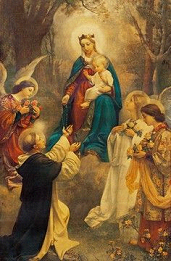 Saint Dominic
Saint Dominic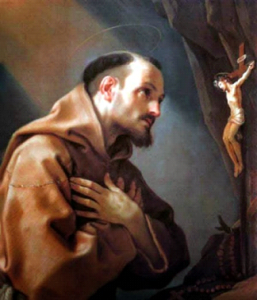 Saint Bonaventura
Saint Bonaventura Saint John of Sahagun or St. Fagondez
Saint John of Sahagun or St. Fagondez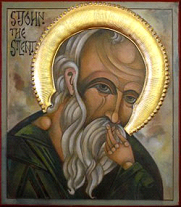 Saint John the Silent
Saint John the Silent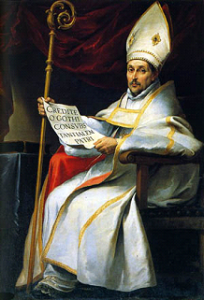 Saint Isidore of Seville
Saint Isidore of Seville Saint John Damascene
Saint John Damascene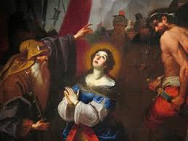 Saint Dorothy
Saint Dorothy Saint Fulgentius
Saint Fulgentius